| Article ID | Journal | Published Year | Pages | File Type |
|---|---|---|---|---|
| 773796 | European Journal of Mechanics - A/Solids | 2009 | 9 Pages |
The nucleation of a Mode-I Zener crack from a wedge disclination dipole in the presence of a circular inhomogeneity is investigated. It is assumed that the disclination dipole and the nucleated Zener crack are along the radial direction of the inhomogeneity. Two cases are studied herein, i.e., the positive or negative wedge disclination of the dipole locates nearer to the inhomogeneity respectively. In order to investigate how various factors such as the elastic mismatch between the inhomogeneity and the matrix influence the nucleation of the Zener crack, the Stress Intensity Factor (SIF) at the sharp tip of the Zener crack is determined for different sets of geometric and material parameters with the distributed dislocation technique. The formulated singular integral equations are then solved numerically. Our results indicate that a nearby ‘hard’ inhomogeneity (having a higher shear modulus than the matrix) is beneficial to the crack nucleation for the first case (the positive disclination locates nearer to the inhomogeneity) while it retards the crack nucleation for the second case (the negative disclination locates nearer to the inhomogeneity). A nearby ‘soft’ inhomogeneity is helpful to the crack nucleation for the second case while it has inverse effects on the crack nucleation for the first case. This phenomenon can be explained with the concept of material force. The characteristics of the crack nucleation and the effects of the disclination strength, the distance between the inhomogeneity and the dipole, the disclination dipole arm length and inhomogeneity size on the crack nucleation are also systematically studied. The obtained results are helpful to characterize and enhance the strength of precipitate alloys and particle reinforced composites.
